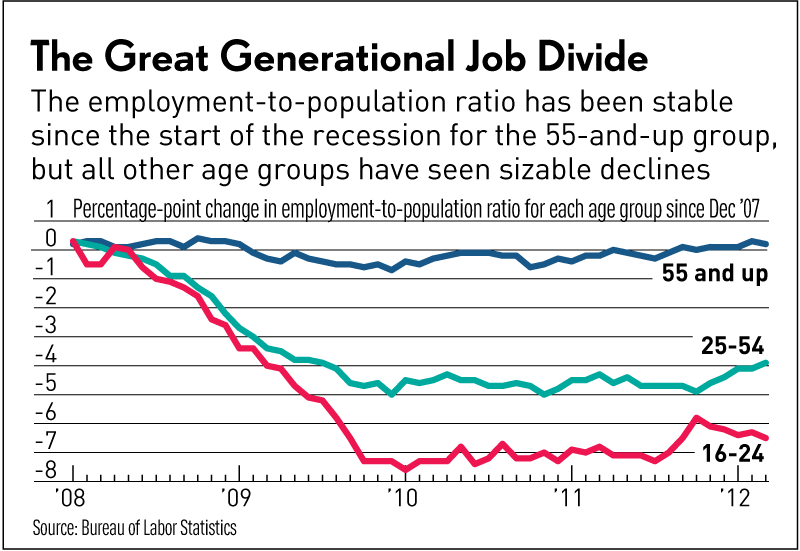Walter Russell Mead writes on the disappearance of jobs for non-Baby Boomers:
An analysis of recent jobs figures at Investor.com reveals a disturbing development: the biggest beneficiaries from the economic recovery are Boomers, while everyone else is getting the shaft.
Since the Obama administration took office, there has been an epochal shift. Young workers have continued to lose jobs and incomes, while older workers have actually gained ground.
In fact, the Obama administration has seen a boom in the prospects of the 55+ crowd; their (I should say ‘our’) employment stands at a 42 year high. Net, there are 3.9 new jobs for people over 55 since the recession began in December 2007, but there are 8.1 million fewer jobs for the young folks since that time.
Jed Graham's IBD article features a chart that shows the employment-to-population ratio that applies for the following age groupings: Age 16-24, Age 25-55 and Age 55 and up:
In the chart, we see that those Age 55 and older would appear to have a near constant share of their population group having jobs.
Meanwhile, we see significant decreases in the employment share of the populations for both the Age 25-54 group and especially for the Age 16-24 group since December 2007, which marks the beginning of the so-called "Great Recession".
We thought that outcome was interesting enough to dig deeper into the data to see how the age distribution of the U.S. workforce has changed over this period of time.
And to make it really interesting, we've decided to go back to November 2006 to do it. Here's why:
- The seasonally-adjusted level of total employment for the U.S. economy hit its all time peak in November 2007, just ahead of the Great Recession. Going back to November 2006 will allow us to capture the last full year of economic expansion for the U.S. economy.
- Coincidentally, the seasonally-adjusted number of teens (Age 16-19), who represent the lowest end of the age groups for which the BLS reports monthly jobs data, and is also the most negatively affected group over this period of time, last peaked in November 2006. Going back to this point in time will also fully capture what has happened with teen employment in the years since.
- The BLS breaks almost all of its age-related jobs data into five-year long cohorts, covering groupings like Age 20 to 24, Age 25 to 29, Age 30 to 34, et cetera. Going back to November 2006 will allow us to see how the employment situation for the same people whose employment was recorded in one of the age groups in November 2006 changed after they all moved up into the next higher age cohort in November 2011.
The downside to our more detailed approach is that we're not going to be able to use the BLS' seasonally-adjusted data for these older five-year age groupings, because the BLS only reports the non-seasonally adjusted data it collects for them, which means that the data we'll be using won't match these more commonly reported values. Still, because we'll be comparing the data for the same month (November) five years apart, our analysis should only differ in very minor respects from what might be achieved using seasonally-adjusted data, if it had been available.
We're going to do this in a three-part series of posts, with this post being the first. Our next stop: the change in the age distribution of the American workforce from November 2006 to November 2011!
Labels: demographics, jobs
Welcome to the blogosphere's toolchest! Here, unlike other blogs dedicated to analyzing current events, we create easy-to-use, simple tools to do the math related to them so you can get in on the action too! If you would like to learn more about these tools, or if you would like to contribute ideas to develop for this blog, please e-mail us at:
ironman at politicalcalculations
Thanks in advance!
Closing values for previous trading day.
This site is primarily powered by:
CSS Validation
RSS Site Feed
JavaScript
The tools on this site are built using JavaScript. If you would like to learn more, one of the best free resources on the web is available at W3Schools.com.
